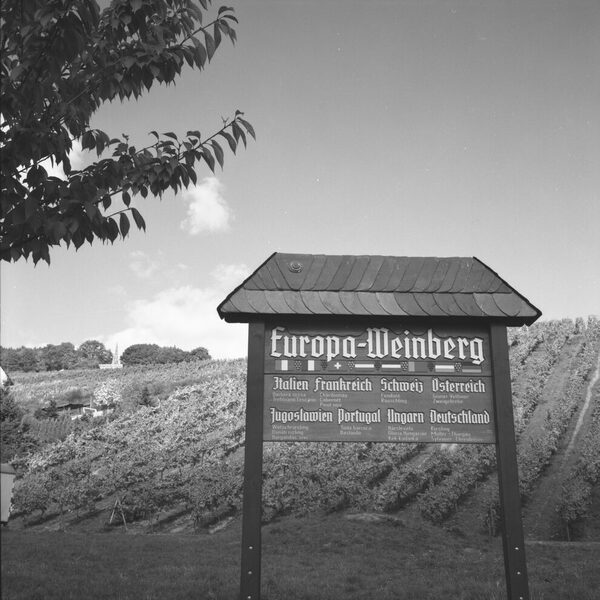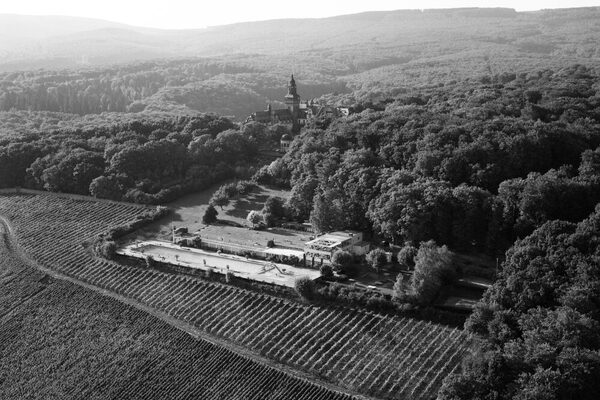Viticulture
There is evidence of viticulture in the Wiesbaden area as early as the 2nd century AD in the form of tool finds. The oldest vineyard in Wiesbaden is considered to be an area in Weidenbornfeld, north of today's Südfriedhof cemetery, the yield of which was donated to St. Jacob's Monastery in Mainz in 1096. There is older documentary evidence for the Wiesbaden suburbs, such as the donation of a royal estate in Kostheim, which included vineyards, to St. Alban's Monastery in Mainz in 927. In 973, Emperor Otto II called vineyards in Schierstein his own. Otto II called vineyards in Schierstein his own.
The Counts of Nassau have owned vineyards in the village since 1369. The local noble families of Allendorf and the Knights of Groenesteyn also had their wines cultivated here. Bleidenstadt Monastery obtained the wine for its abbot from its Schierstein estates. In 1570, 120 winegrowers are mentioned here who harvested around 120,000 liters of grape juice annually. Official documents repeatedly refer to viticulture in other places in the region, such as Biebrich in 991 and Kastel in 1090. In 1275, vineyards are mentioned in Dotzheim, where Eberbach Monastery and the Archbishop of Mainz owned extensive vineyards in the 14th century. Frauenstein first appears in documents in the 12th century. In addition to the Archbishop of Mainz, lower nobles and burghers also cultivated their wine below the castle. The Frauenstein vineyard "Marschall" would later achieve some fame. Vineyards in Nordenstadt were mentioned in documents in 1263, and 52,000 liters of grape must were still being pressed in 1707. Viticulture was discontinued in the 1970s.
Wiesbaden's districts, where today mostly only field or street names remind us of viticulture, were also planted with vines in the old days. There were considerable vineyards in Breckenheim around 1500, from which the mass wine for the Bleidenstadt monastery came. An interest register from 1589 lists numerous vineyards in Biebrich. Vineyards in Erbenheim are first mentioned in the middle of the 16th century. Vineyards have been cultivated in Delkenheim since 1290.
In Wiesbaden, the Counts of Nassau owned a vineyard on the Heidenberg in 1279. The Thirty Years' War also had a devastating effect on local and regional viticulture in Wiesbaden. In the 18th and especially in the 19th century, the growing bourgeoisie placed increasingly high demands on wine quality. Many poor vineyard sites could no longer meet these demands and were subsequently used for other agricultural purposes. In Biebrich and Kastel, however, the last winegrowers did not give up their vineyards until the 1980s.
Today, only six of Wiesbaden's 26 districts still have a total of 239 hectares of officially recognized vineyards. Currently, 183 ha - i.e. around three quarters - are planted with vines. Almost half of this is in Kostheim (89 ha, sites: "Berg", "Reichestal", "St. Kiliansberg", "Steig" and "Weiß Erd"). The districts of Frauenstein (51 ha, location: "Herrnberg") and Schierstein (35 ha, locations: "Herrnberg" and "Hölle") also still play an important role in Wiesbaden's viticulture. The current cultivation areas in Wiesbaden-Nordost (3.4 ha, location: "Neroberg"), Dotzheim (3.3 ha, location: "Judenkirsch") and Delkenheim (1.6 ha, location: "Grub") are comparatively small.
In an average wine year, however, Wiesbaden's winegrowers bring 15,000 hl of the coveted grape juice into their cellars. With a share of around 80%, Riesling dominates as it always has. Pinot Noir follows at a considerable distance in terms of volume (approx. 10%). The size of the vineyards has not decreased any further in recent years, but the number of individual vineyards in Wiesbaden has. In 2008, the official vineyard register still listed 13 sites, but now shows only 10, with the smallest sites being added to the larger sites. The fact that the sparkling wine producers Henkell (founded in 1856) and Söhnlein (founded in 1864) settled here is proof of Wiesbaden's close ties to viticulture.
In 1893, the Wiesbaden magistrate vigorously supported the wine lobby when it was necessary to fend off the impending wine tax. In its petition to the Reichstag, it claimed to be the "headquarters of the Rheingau wine trade". For a long time, Wiesbaden was indeed the headquarters of the Rheingau Wine Merchants' Association, which counted 130 businesses as members (1926). There used to be vineyards in many places, such as on the upper Michelsberg, on the slope to Saalgasse, on the Leberberg, on the Riederberg and also in the Aukamm. However, the quality was not always the best. The wines from the nearby communities of Schierstein and Biebrich, for example, always fetched the higher prices. The only wine-growing area in the town that was used as such until the 20th century - apart from the Neroberg - was the "Langelsweinberg" to the east of St. Josef's Hospital. In 1900, the Neroberg southern slope was threatened with lucrative marketing as a residential area by the Kingdom of Prussia. Wiesbaden acquired the slope for 250,000 gold marks and, as the new owner, continued its wine-growing tradition. This had already begun in 1525. Count Philipp zu Nassau-Weilburg initiated the planting of Riesling vines.
Until recently, the vineyard on the Neroberg was rarely economically productive. The "1893 Neroberger feinste Auslese", which Kaiser Wilhelm II presented to the public in his goblet at the inauguration of the Kurhaus in 1907, achieved greater fame. The last available bottle of this vintage was an "1893 Neroberg Riesling Trockenbeerenauslese", which was auctioned off in 1986 for the fabulous sum of DM 35,000 and stored in the treasure cellar of Eberbach Monastery. In 2005, the Hessische Staatsweingüter took over the Neroberg on lease. Today, the "Neroberger" is increasingly appreciated by Wiesbaden traders, restaurateurs and private customers.
Since 1976, the Rheingau Wine Week has been held in Wiesbaden every August, where around 1,000 different wines from Wiesbaden and the region can be tasted at more than 100 stands.
Literature
Daunke, Manfred: Die nassauisch-preußische Weinbaudomäne im Rheingau 1806-1918. Geschichtliche Landeskunde Bd. 63, Stuttgart 2006.
Daunke, Manfred: The Neroberg in Wiesbaden. In: Rheingau Forum, 2/2008 [pp. 24-27].
Horn, Günter: Selections from the history of wine in Wiesbaden. Magistrat der Landeshauptstadt Wiesbaden, Amt für Landwirtschaft, Forsten und Naturschutz (ed.), Wiesbaden 1994.

